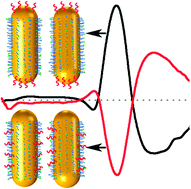Plasmonic circular dichroism in side-by-side oligomers of gold nanorods: the influence of chiral molecule location and interparticle distance†
Abstract
Chiral metal nanostructures, which exhibit plasmonic circular dichroism (PCD), have great potential for the development of chiral sensors and devices. Previously, we developed a method for fabricating chiral gold-nanorod oligomers: the nanorods are linked by achiral molecules, while chiral molecules (e.g.L- or D-cysteine) on the Au surface exert a directional twisting force on the oligomers and thereby generate a PCD signal. In this paper, we investigate how the location of chiral molecules and the interparticle distance affect the PCD of the oligomers. Cysteine at the ends of the nanorods and those on the side were found to induce PCD with opposite signs. When we increased the interparticle distance, the PCD signal was weakened; in particular, cysteine at the ends lost the twisting effect. Besides introducing the twisting force at the Au surface, chiral molecules in the hydrophobic surfactant bilayer and those adsorbed outside the surfactants can also twist the oligomers and generate PCD signals. These findings not only provide guidelines to the manipulation of PCD signals, but also serve as a more elaborate platform for studying the nanoscale interactions between nanoparticles.


 Please wait while we load your content...
Please wait while we load your content...